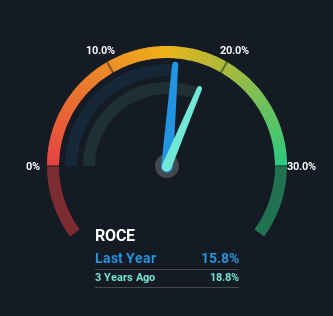
Finding a business that has the potential to grow substantially is not easy, but it is possible if we look at a few key financial metrics. One common approach is to try and find a company with returns on capital employed (ROCE) that are increasing, in conjunction with a growing amount of capital employed. Ultimately, this demonstrates that it's a business that is reinvesting profits at increasing rates of return. So, when we ran our eye over Hitachi Energy India's (NSE:POWERINDIA) trend of ROCE, we liked what we saw.
Return On Capital Employed (ROCE): What Is It?
If you haven't worked with ROCE before, it measures the 'return' (pre-tax profit) a company generates from capital employed in its business. The formula for this calculation on Hitachi Energy India is:
Return on Capital Employed = Earnings Before Interest and Tax (EBIT) ÷ (Total Assets - Current Liabilities)
0.16 = ₹2.0b ÷ (₹40b - ₹28b) (Based on the trailing twelve months to December 2023).
So, Hitachi Energy India has an ROCE of 16%. In absolute terms, that's a pretty normal return, and it's somewhat close to the Electrical industry average of 18%.
Check out our latest analysis for Hitachi Energy India

Above you can see how the current ROCE for Hitachi Energy India compares to its prior returns on capital, but there's only so much you can tell from the past. If you'd like to see what analysts are forecasting going forward, you should check out our free analyst report for Hitachi Energy India .
What Does the ROCE Trend For Hitachi Energy India Tell Us?
The trend of ROCE doesn't stand out much, but returns on a whole are decent. The company has consistently earned 16% for the last three years, and the capital employed within the business has risen 37% in that time. 16% is a pretty standard return, and it provides some comfort knowing that Hitachi Energy India has consistently earned this amount. Over long periods of time, returns like these might not be too exciting, but with consistency they can pay off in terms of share price returns.
Another thing to note, Hitachi Energy India has a high ratio of current liabilities to total assets of 68%. This effectively means that suppliers (or short-term creditors) are funding a large portion of the business, so just be aware that this can introduce some elements of risk. While it's not necessarily a bad thing, it can be beneficial if this ratio is lower.
The Bottom Line
To sum it up, Hitachi Energy India has simply been reinvesting capital steadily, at those decent rates of return. And the stock has done incredibly well with a 519% return over the last three years, so long term investors are no doubt ecstatic with that result. So even though the stock might be more "expensive" than it was before, we think the strong fundamentals warrant this stock for further research.
If you want to continue researching Hitachi Energy India, you might be interested to know about the 1 warning sign that our analysis has discovered.
While Hitachi Energy India isn't earning the highest return, check out this free list of companies that are earning high returns on equity with solid balance sheets.
Valuation is complex, but we're here to simplify it.
Discover if Hitachi Energy India might be undervalued or overvalued with our detailed analysis, featuring fair value estimates, potential risks, dividends, insider trades, and its financial condition.
Access Free AnalysisHave feedback on this article? Concerned about the content? Get in touch with us directly. Alternatively, email editorial-team (at) simplywallst.com.
This article by Simply Wall St is general in nature. We provide commentary based on historical data and analyst forecasts only using an unbiased methodology and our articles are not intended to be financial advice. It does not constitute a recommendation to buy or sell any stock, and does not take account of your objectives, or your financial situation. We aim to bring you long-term focused analysis driven by fundamental data. Note that our analysis may not factor in the latest price-sensitive company announcements or qualitative material. Simply Wall St has no position in any stocks mentioned.
About NSEI:POWERINDIA
Hitachi Energy India
Offers products, projects, and services for electricity transmission and related activities in India and internationally.
Exceptional growth potential with outstanding track record.
Similar Companies
Market Insights
Community Narratives



